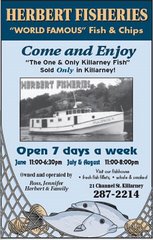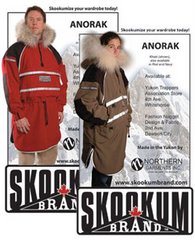

Certainly a weekend that will require some rest afterwards. It is Rendezvous weekend here in Whitehorse and the town fills with people out enjoying the activities and events.
With the exception of today, I have been out with the dogs every day since my last post. Each time, I have taken a passenger which is great strength training for the dogs. On Thursday, Jenn's mother went out with me at night. It was an absolutely clear night with a bright full moon. Most of the run was done without the headlamp. We went about 12 miles and arrived back home twenty minutes faster than I had expected, even though Bluegrass, the new dog, didn't pull at all. To be honest, she was a complete bonehead. She was by herself in the position just ahead of the wheel dogs, which is the easiest position in the team. She looked around, she tried to turn around a few times, all the bad behaviour of a dog that didn't want to run. However, the temperature was only -13 or so; a really nice temperature to travel at because the dogs don't get as hot and yet it is comfortable for the passenger, too. Jenn's mother, Nancy, got to drive the sled across the lake which I think she enjoyed and I got to see the scenery from the bed of the sled for once.
On Friday, it was again too warm during the day to go out and because I had a big run planned for Saturday morning, Jenn and I just went out on a quick 6 mile run around 2200. We just went across the lake, through the bush and back down a laneway near our house... I don't even think the dogs knew we had gone out we went so fast. It is good for them to learn how to work hard, but they also have to enjoy what they are doing so a short, fast run is often benefitial to their mental well being. I took all seven dogs, even though I had reservations about Bluegrass. I thought that because it was such a short run, I'd give her another chance, so I put her in wheel with Ben. She was very good. She pulled the whole way; in fact, she loped the entire six miles.
First, in case the positions of dogs are not familiar to the reader, the order goes: Lead dogs, Swing (or Point) dogs, Team dogs and then Wheel dogs, which are the dogs just in front of the sled. Each dog has it's special task: Lead dogs are expected to keep the gangline strung out and tight, whether they are running or not. They are also supposed to take commands from the driver. They are not necessarily the strongest dog in the kennel, the most dominant or the one with the best relationship to the musher. Often, they are just like the other dogs. They are also not expected to pull the hardest, as long as they manage to keep the lines tight.
The Swing dogs are just behind the lead dogs and their job is to pull but also to help turn longer strings of dogs. A team of eight dogs is roughly 35 feet long and going around a corner takes practice, both on the part of the driver and the team. Basically, the swing dogs take the corner wider than normal so that the team stays on the trail.
The team dogs are the power. They are the ones who pull, pull, pull. That is all they are expected to do. Good team dogs can change gaits easily from a lope to a trot. Most distance mushers favour a trot because the dogs can cover a lot of ground without getting tired. It is the most energy efficient gait. As well, a good team dog knows how and when to rest when they are pulling. Most often the dog will stop pulling and just trot along with the team for a short distance and then they will lean into their harness again and resume pulling. There is a fine line between being a good, hardworking dog that knows how to rest and being lazy. Although the job of the team dog is to pull, there is one position on the gangline that is easier than the rest. Just in front of the wheel dogs is the 'resting position' and this is sometimes used for dogs that either need more than a few minutes break or dogs that are not as strong as the others but need the training to catch up.
Lastly, there are the wheel dogs. Their job is to pull and to help steer the sled. Because their lines come straight off the sled line, when they turn they pull the nose of the sled one way or the other. A wheel dog that is not pulling its' share is quickly noticed because it is more difficult to turn to that side. Also, the wheel dogs have to be tough both physically and mentally. Again, because their lines are attached almost directly to the sled, they get a lot of jerking on bumpy trails and downhill trails can see the sled creep up behind them. Some dogs cannot deal with this sort of pressure and they will not perform well in this position.
Fortunately, it was still cool on Saturday morning. I had plans of getting up at 0545 and feeding the dogs a broth before we were to leave. I like to give them water before we go so that I know they are not getting dehydrated and so that they don't 'dip' as much. 'Dipping' is when they grab at snow on the ground as they run. Some mushers completely discourage this behaviour, while others don't mind, their philosophy being any moisture the dog can get is welcomed. I don't mind the dogs doing this, as I share the above philosophy, but I find it can slow down a team if the behaviour becomes excessive so if I can meet their liquid needs with a pre-run broth I will. Anyway, I also like to give them about an hour between the run and the broth so they are not going on full stomachs, so I had set my alarm for 0545 with the hopes that we'd be able to get away by seven at the latest. I wanted to go early because of the temperatures, for one thing, and for another, we were going to Teslin -- a two hour drive -- after my run.
As it was, my alarm didn't go off and I ended up sleeping an extra hour so Nancy and I didn't get away until 0800. I was really eager to be underway, too, because we were going part way up the mountain and this was going to be the dogs longest and most difficult run to date. I have a lot of faith in our dogs, but I have not really pushed them too hard, so they have not really learned how to work hard and this run would require just that. I was going to put Bluegrass in the position just ahead of the wheel dogs because she would be going quite far, but I thought back to Thursday nights run and decided that I would put her in wheel to start and if she got tired, I'd move her later.
Nancy and I were gone for three hours. I would expect that we covered just over 35 miles -- 30 for sure -- and the dogs were great. Amber and Crystal were nearly flawless in lead -- even managing a head-on pass with a skier and their dog -- and I never did end up switching Bluegrass, who pulled solidly the entire run. I guess wheel is her position. I suspect that, being new to sledding, she is uncomfortable with a dog behind her and prefers the security of being the last dog.
I was very impressed -- and pleasantly surprised -- with our dogs. I wasn't sure how they would do on the long run, up a mountain, with a heavy sled. They were super tired when we got back, but they never quit. Of course they were given breaks on the way back, but we never stopped for more than thirty seconds and they were lunging at their harnesses to go again. I have to say, I think that the team has graduated to a new level. I was very proud of them.
The dogs get a day off now. It is +6 and lightly raining but they were going to get a break anyway. Hopefully tomorrow is a cooler day and we can go out again.
 "Happiness is not achieved by the conscious pursuit of happiness; it is generally the by-product of other activities"
- Aldous Huxley
"Happiness is not achieved by the conscious pursuit of happiness; it is generally the by-product of other activities"
- Aldous Huxley




































